NB-IoT vs LTE-M: Here's What The Cellular IoT Buzz Is All About
In this breakdown, we take a look at two of the hottest technologies in cellular IoT: NB-IoT vs LTE-M. Take a sneak peek at the future!

In short, NB-IoT is ideal for low data rate use cases which do not require high refresh rates (think smart metering) while LTE-M is great for mobility and voice as it supports VoLTE technology for use cases like smart security. Range and battery life are comparable for both.
With cellular IoT technologies like NB-IoT and LTE-M rising in popularity, the Internet of Things is finally moving towards a mobile-first world.
Also known as LTE Cat-NB1/NB2 and LTE Cat-M1/M2, NB-IoT and LTE-M are technologies developed by the global standards organization 3GPP. Here's a table that recaps all cellular IoT technologies made available up to this point:
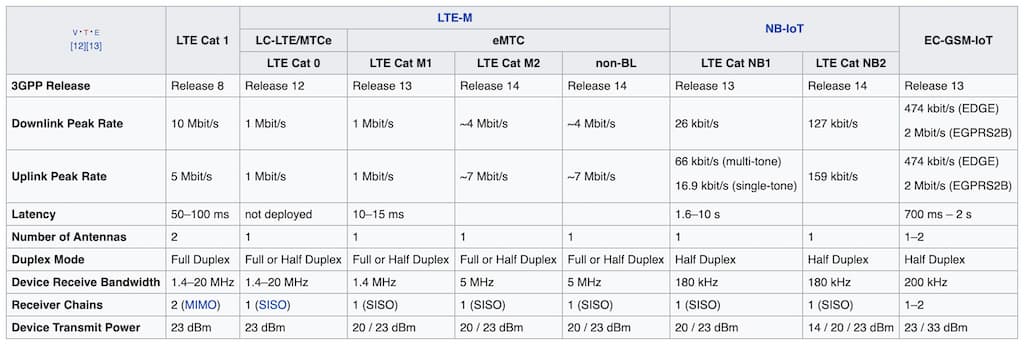
Finding the naming scheme a bit confusing?
That's because it is confusing.
The fact that 3GPP is adding both the "5G" and the "NR" (New Radio) branding to their IoT offering starting with release 15 of their specifications isn't helping much either. For example, here's a recent poster they've published:
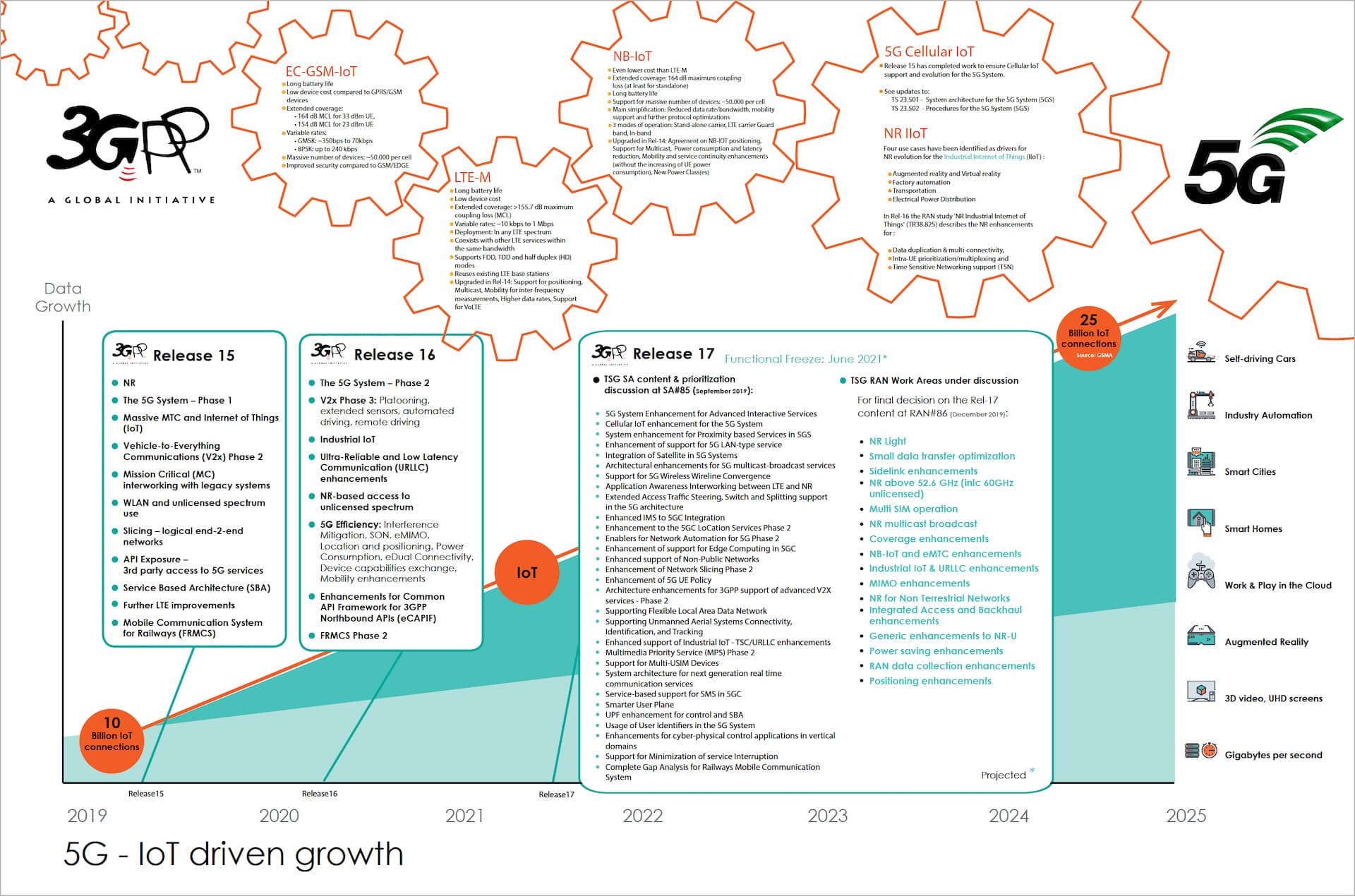
While interesting to look at, this list of features didn't help us make an informed decision about which cellular IoT protocol is best for a specific use case so we decided to paint a clearer picture instead.
Keep on reading for detailed information about how 3GPP's naming scheme works and why this matters for our in-depth comparison between two of the biggest names in the cellular IoT game: NB-IoT vs LTE-M.
How 3GPP's Naming Scheme Works
In consumer markets, 5G is all the network providers are raving about in 2020, but cellular IoT requires more than "just" a speed bump or a rebrand to make sense.
Since we're talking about cellular networks, it's important to understand the basics of 3GPP's naming scheme and how they iterate on their technologies.
As clearly highlighted by Ericsson in their cellular IoT "alphabet soup":
3GPP uses the concept of “Releases” to refer to a stable set of specifications which can be used for implementation of features at a given point of time.
If we look at the poster above, we can see that we're currently in the early stages of Release 16, with Release 17 scheduled for delivery in June 2021.
Informally known as NB-IoT and LTE-M, the two protocols were launched in 2017 as part of Release 13, starting out as LTE Cat-NB1 and LTE Cat-M1 (were "Cat" stands for category, "NB" stands for narrowband and "M" stands for machine).
Let's look at both of these protocols side by side.
NB-IoT vs LTE-M: An In-Depth Comparison
Before we jump into the comparison, here's a quick definition for both protocols, together with their first and second generation categories.
NB-IoT
Referring back to one of 3GPP's press releases from Feb 2016, NB-IoT is defined as "a new radio added to the LTE platform, optimized for the low [bandwidth] end of the market." In their 2017 Cellular Internet of Things recap, they expand on this concept by highlighting some key NB-IoT features and benefits:
NB-IoT can operate over a system bandwidth as low as 200 kHz and supports a min. channel bandwidth of 3.75 kHz. This gives an unmatched spectrum flexibility and system capacity, in combination with qualities such as energy efficient operation and ultra-low device complexity.
NB-IoT was made with low-power stationary sensors in mind.
Boasting a slightly higher refresh rate compared to IoT protocols like LoRaWAN, NB-IoT is perfect for use cases where remote, stationary data connectivity is a requirement (think smart metering for fuel tanks, smart parking lots, etc).
Latency is high at ~1.5/10 seconds.
Since there is a lot of confusion on the naming, it's important to note that the Cat-NB1/NB2 categories are rather elusive (navigating 3GPP's release documents is arduous to say the least) but crucial to the understanding of NB-IoT.
Here's a table highlighting the differences between the two of them:
| LTE Cat-NB1 | LTE Cat-NB2 | |
|---|---|---|
| Max Downlink TBS | 680 bits | 2536 bits |
| Max Downlink Data Rate | ~26 kbps | ~80/127 kbps |
| Max Uplink TBS | 1000 bits | 2536 bits |
| Max Uplink Data Rate | ~62 kbps | ~105/159 kbps |
| Positioning | Cell ID | OTDOA, E-CID |
Source: Haltian
We've kept the table fairly streamlined not to add any unnecessary details. In simple terms, LTE Cat-NB2 is an incremental improvement over LTE Cat-NB1, allowing for bigger Transport Block Size (TBS) and higher max data rates.
Another big improvement with LTE Cat-NB2, especially for remote use, is the introduction of OTDOA (Observed Time Difference of Arrival) and E-CID (Enhanced Cell ID), allowing for higher location accuracy.
But the biggest and most welcomed change is in regards to mobility. Cat-NB2 introduces reconnection in device connected mode, unlike Cat-NB1's idle mode-only reconnection which wouldn't allow any sort of mobile functionality.
It's also worth mentioning that NB-IoT is already deployed in many countries across the globe, with particular concentration in the European area:
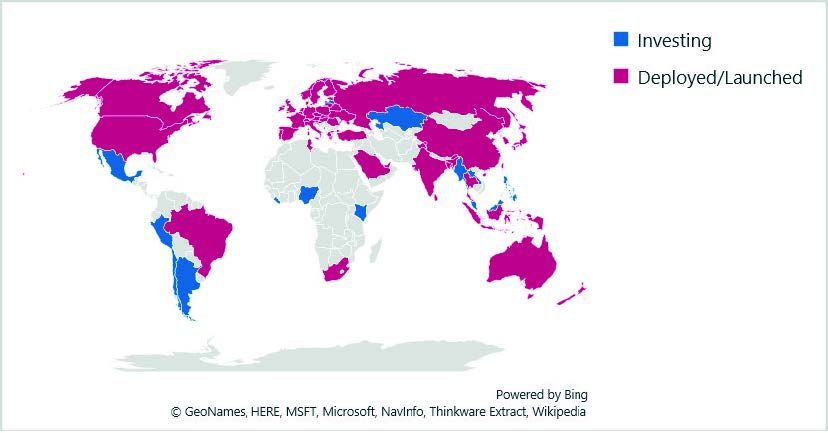
In the United States, Verizon brought nationwide NB-IoT network coverage to "more than 92% of the US population" back in May 2019, allowing businesses to choose from a variety of data plans for IoT applications.
LTE-M
LTE-M is an abbreviation of LTE-MTC, where "MTC" stands for Machine Type Communication. Since 3GPP Release 13, LTE Cat-M1 was placed under the "eMTC" specification (or enhanced Machine Type Communication), later to be joined by its more recent version—LTE Cat-M2.
Quoting 3GPP directly:
The main components of LTE-M are a series of low-cost device categories (e.g. Cat-M1 and Cat-M2) and two coverage enhancement modes (i.e. CE modes A and B). LTE-M was designed to reduce the device complexity to make LTE competitive with EGPRS in the MTC market. It supports secure communication, ubiquitous coverage, and high system capacity.
LTE-M offers lower latency and higher throughput compared to EC-GSM-IoT, NB-IoT, and most other technologies in the cellular IoT space. Therefore, it also consumes more energy and isn't employed in as many networks as NB-IoT.
Just like NB-IoT categories, it's also important to understand the difference between LTE-M's categories: Cat-M1 and Cat-M2 (we'll leave non-eMTC technologies like LTE Cat-0/1 to the side for now).
Here's a quick roundup of differences between the two:
| LTE Cat-M1 | LTE Cat-M2 | |
|---|---|---|
| Transmit & Receive Bandwidths | 1.4 MHz | 5 MHz |
| Channel Bandwidth | 6 PRBs | 24 PRBs |
| Max Downlink TBS | 2984 bits | 4008 bits |
| Max Downlink Data Rate | 1 Mbit/s | ~4Mbit/s |
| Max Uplink TBS | 2984 Bits | 6968 bits |
| Max Uplink Data Rate | 1 Mbit/s | ~7 Mbit/s |
Source: ScienceDirect
Just like LTE Cat-NB2, LTE Cat-M2 is an incremental improvement aimed at providing more bandwidth while keeping the complexity relatively low.
With 5 MHz transfer/receive bandwidths and four times the Physical Resource Blocks (PRBs), LTE Cat-M2 supports higher data rates for faster connectivity.
For reasons regarding accessibility and ease of deployment, LTE-M hasn't experienced nearly the same growth rate as NB-IoT across many developed countries (and is more concentrated in the North American area):
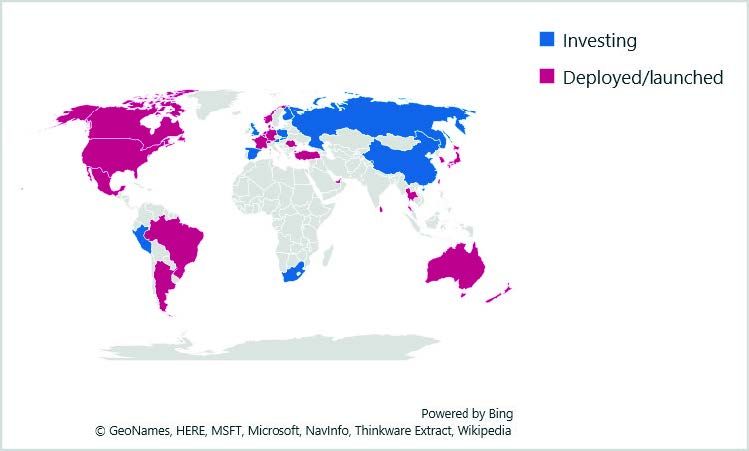
The Differences Between NB-IoT & LTE-M
Based on the previous definitions and the short video shown above, the differences between NB-IoT and LTE-M can be recapped as follows:
| NB-IoT | LTE-M | |
|---|---|---|
| Peak Data Rate | <100 kbps | >384 kbps, up to 1Mbps |
| Latency | 1.5-10 s | 50-100 ms |
| Power Consumption | Best at very low data rates | Best at medium to high data rates |
| Mobility | No for Cat-NB1, limited for Cat-NB2 | Yes |
| Voice (VoLTE) | No | Yes |
| Antennas | 1 | 1 |
NB-IoT is optimized for:
- Low data rate connections
- Stationary use (with Cat-NB2 allowing for limited mobility)
- Extremely low cost per device
On the other hand, LTE-M is great for:
- High bandwidth data rates
- Mobility (asset tracking, vehicles, etc.)
- Voice connectivity through VoLTE technology
This paints a picture where NB-IoT is best suited for low-cost industrial and infrastructure-related use cases while LTE-M is ideal for enterprise customers interested in transportation and logistics, including supply chain tracking.
Here are some of the best use cases for each protocol:
| Application | NB-IoT | LTE-M |
|---|---|---|
| Smart Cities | Stationary applications with low bandwidth requirements such as smart parking, noise and pollution monitoring, waste management, and smart traffic monitoring. | Applications with heavy downlink requirements and/or voice support such as street lighting, traffic management, panic buttons, and SOS stations with optional voice support. |
| Smart Agriculture | Stationary applications with low bandwidth requirements such as weather stations, soil moisture/temperature and humidity levels, and other environmental applications. | Applications with heavy downlink requirements and/or mobility such as smart irrigation, HVAC control in animal housing, and live animal tracking. |
| Logistics & Transportation | Semi-stationary assets such as commercial refrigeration equipment (ice cream, beverages, etc.) and on-site logistics equipment (racks, trolleys, lifts, and other warehouse machinery). | Personal tracking applications (cars, bikes, pets, children), fleet monitoring (especially trucks), and non-stationary assets such as logistics equipment (cargo, crates, pallets, etc.). |
| Industrial & Manufacturing | Stationary machinery with low data rates for process variables indirectly affecting production or quality, industrial assets tracking, and energy monitoring. | Machinery with higher bandwidth requirements for process variables directly affecting production or quality, IoT gateways linked to PLCs for tags monitoring, and worker monitoring. |
How The Market Is Reacting To NB-IoT & LTE-M

Ever since Release 13, network operators have introduced a number of innovations for their infrastructure, supporting both NB-IoT and LTE-M in some cases.
Here are some stats provided by GSA's Global Ecosystem and Market Status report (released in April 2019 and likely due for an update soon):
- 141 operators are actively investing in NB-IoT networks, 90 of which are fully deployed and ready to be used commercially.
- 60 operators make use of LTE-M networks instead, with 34 of them fully deployed and ready to use for commercial purposes.
From April 2018 to April 2019, 29 countries have launched NB-IoT only networks while 2 countries have launched LTE-M only networks. This clearly shows that NB-IoT is the leading technology among all of 3GPP's cellular IoT categories.
Here's a visualization of countries with deployed NB-IoT and LTE-M networks:
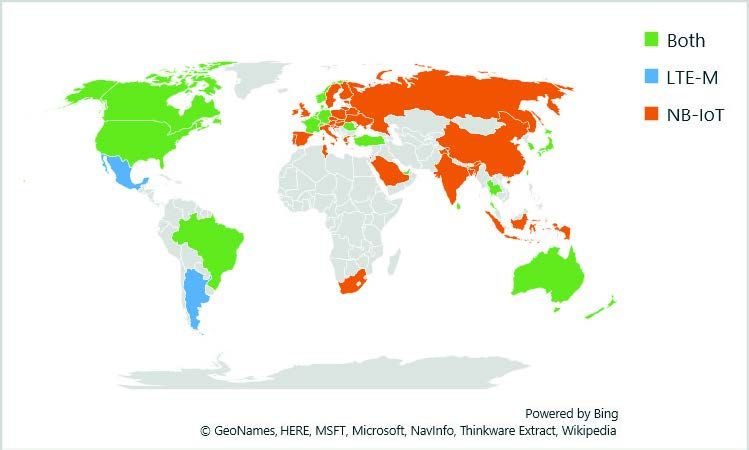
But the story doesn't end there. GSA's report also provides us with revealing numbers regarding device form factor and chipset availability:
- Globally, there are currently 142 recognized devices supporting all variants of NB-IoT, with 76 of them supporting Cat-NB1 only (the first version of NB-IoT).
- Similarly, 134 devices support LTE-M, with 68 of them supporting Cat-M1 only.
With 24 commercially available chipsets across both NB-IoT and LTE-M, the IoT landscape is becoming more diversified and affordable, even for enthusiasts.
In terms of form factor, the most popular hardware use case for these chipsets is modules, with asset trackers and other types of hardware "lagging" far behind:
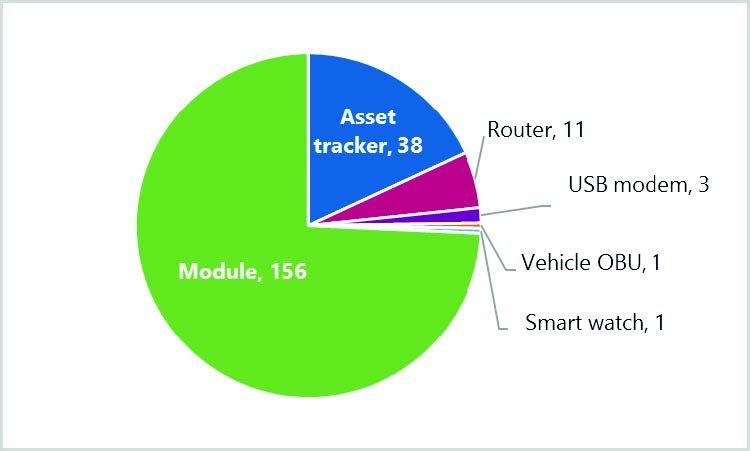
Some examples of devices supporting these chipsets are:
- The Boron LTE from Particle: an LTE CAT-M1/NB1 enabled development board that can act as a standalone cellular endpoint.
- The NL-AT2 from NimbeLink: an asset-tracking device that leverages cellular connectivity to deliver high-end monitoring capabilities.
- The Wio LTE from Seeed: a board designed specifically with cellular IoT deployment in mind (both Cat-NB1 and Cat-M1).
With this data in mind, and considering the differences in performance between NB-IoT and LTE-M, deciding which protocol to use is entirely up to the providers.
A Bright Future For Both NB-IoT & LTE-M

Confusing naming and 5G branding aside, the future is bright for both NB-IoT and LTE-M. Predictions from Statista show that NB-IoT will reach 750+ million connections by 2023, going directly against the non-cellular LoRa technology.
GSMA, similarly to GSA, also reports that a total of 127 commercial networks were launched with either LTE-M or NB-IoT (with the second one taking the lead due to ease of deployment), a trend that shows no signs of stopping.
In a world that's increasingly connected, what's your take on the cellular IoT craze? Let us know in the comments down below and don't forget to share the article!


